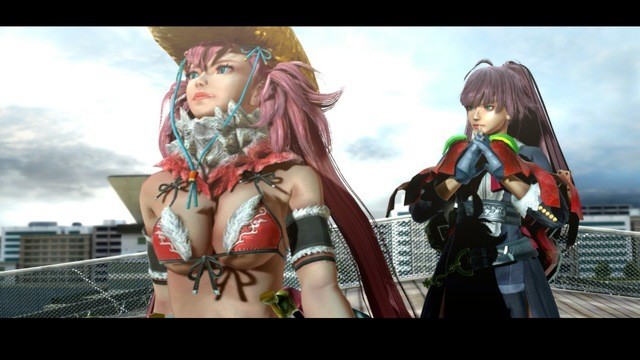Luridly dressed cowboy vampires slice apart mutant moles and mythological samurai – that’s all the premise it takes for a video game series to find a sequel. Or three.
Onechanbara should always ship in a heavily creased, sun-faded VHS box. Or maybe not sun-faded, since it would be relegated to a video store’s “special” back room. With total bombast, this tactless and risque venture envelopes itself in the industry’s war on objectivism as only a Japanese production would. The unusual comfort in making puns about breasts and teasing lesbianism is a complete absurdity, near satire if there were any evidence Onechanbara was trying to express something of merit. It’s a shame then, because it’s not.
Fighting Foursome
Instead, the third-person brawler-style combat – with colored laser swipes, steamy decoration, and scattering blood – is more dressed up than the women. Limited character from the foursome of Aya, Saaya, Saki, and Kagura means their definition is purely physical. Some wear more clothes than the other. The cheery, friendly one is dressed modestly, the more outgoing ones ignoring practicality. How their clothing stays on is of more concern than killer rodents.
Those women are part of the Zombie Punitive Force who clearly do not adhere to any dress code. Onechanbara markets itself on sex (it does still sell) and a brawler power fantasy, but completely unlike Sega’s glamorous Bayonetta. She puts herself and her sexuality out there willingly. Here the camera is expressly lurid in its positioning. Plastic-looking, doll-like members of the ZPF hang at the beach while a pervy invisible camera sweeps around to catch the sun glistening from their exposed skin… which is all of it, mostly.
Third-person camera work ensures a low, rear-facing view, perfect to enhance what Onechanbara is selling.
In its own way, Onechanbara is stupendously explicit. Titillation is surrounded by goop. All manner of bodily fluids scatter onto stuff like the screen, skin, the ground, swords, fists; nothing is able to escape being drenched. In action, third-person camera work ensures a low, rear-facing view, perfect to enhance what Onechanbara is selling. It’s too cheap, too easy, and too sleazy.
Through the years of its existence, Onechanbara has never climbed from its Z-grade aspirations. Why would it need to? The same as low budget horror cinema panders to natural instinct, fast food advertisers like Hardee’s expose bikini lines, and free-to-play mobile games dress Kate Upton in busom-busting armor. There is little need for Onechanbara to do anything different, so it doesn’t. Levels are still corridors and fights are overlong slogs.
Busy Bodies
Onechanbara doesn’t introduce any dialog other than to say, “Look at me.”
For credit, melee chops have expanded with the series. There’s weapon sets and meters and blinking icons and combos; the mess of indicator lights and available button presses are convoluted. Onechanbara barely explains itself – it’s immediately onto the blood and boobs. It should appease the impatient hormonal teenager who excitedly sees the “explicit nudity” moniker in the MPAA’s movie rating box, only to be frustrated when everything is stalled by plot. That’s not a problem here.
Onechanbara would fall into specific categorization if there were anything to consider. For comparison, ’70’s era Blaxsploitation chiseled into a cultural niche to represent the under or unrepresented. The images of urban ghettos spread outside of the intended audience. Many of those films – Shaft, Coffy among them – are credible cultural milestones in spite of their sleaze and pandering violence. They had a voice. Onechanbara doesn’t introduce any dialog other than to say, “Look at me.”
It won’t move beyond the intended demographic of the 20-something who needs digital arousal and histrionic violence because it refuses to do anything other than expose fake skin. How boring.









Published: Aug 1, 2015 11:20 am